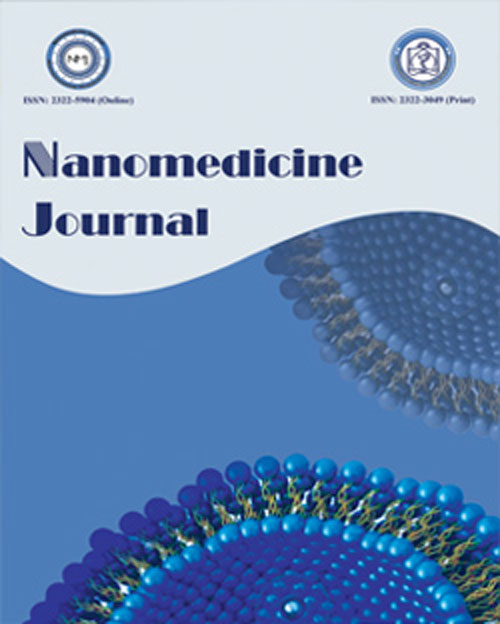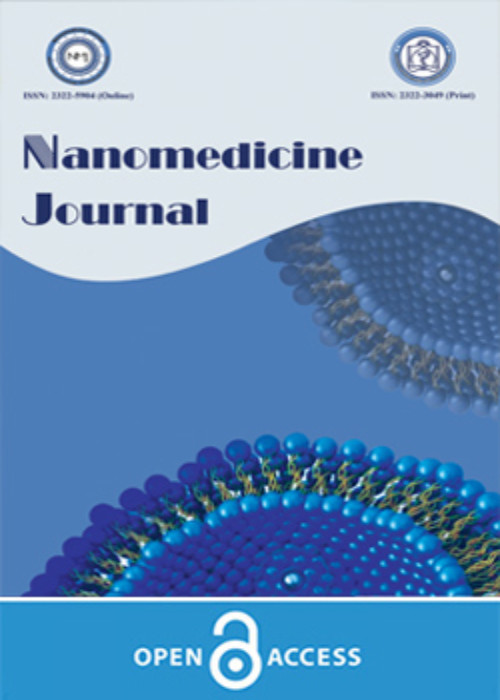فهرست مطالب

Nanomedicine Journal
Volume:9 Issue: 2, Spring 2022
- تاریخ انتشار: 1401/01/12
- تعداد عناوین: 8
-
-
Pages 95-106
Breast cancer is a public health problem globally and is the most frequent cancer world wide. Currently, anti-inflammatory and anti-cancer drugs are of prime interest in treating some cancers especially breast cancer and have become an exciting challenge for researchers. The use of layered structures consisting of anions and cations called layered double hydroxides (LDHs) has attracted the attention of many researchers in the field of biomedical and pharmaceuticals. LDHs-nanostructures can be used as drug carriers, especially anti-inflammatory and anti-cancer drugs to treat cancers. Thus, the LDHs should have a number of physicochemical properties to act as a desirable drug carrier. Among the primary factors to increase the efficiency of LDHs are their surface characteristics and size, number and type of ions, rapid clearance from the body after drug release, and non-toxicity. All of these properties make LDHs nano-carriers for carrying anti-inflammatory and anti-cancer drugs to treat a variety of cancers. Therefore, we focus on reviewing the nature of LDH nano-carriers and evaluating the desirable properties for drug delivery, drug loading methods into LDH and anti-inflammatory drug delivery methods, their potential applications in biomedical and their toxicity and antimicrobial effects in breast cancer.
Keywords: Anti-inflammatory drugs, Breast Cancer, Cancer therapy, LDH nanostructures, Nano-carriers -
Pages 107-130
Medical imaging is currently revolutionizing the diagnosis and treatment of a variety of diseases. Several imaging modalities have been developed based on advances in science and engineering. The impact of these imaging tools has been further improved with the advent of various modern chemistries, leading to the development of contrast agents that serve further to localize the detection of diseased tissues. Several researchers are recently involved in engineering contrast agents that can generate contrast differences between tissues in multiple imaging modalities, enabling cross-referenced determination of anomalies. To establish these multimodal imaging agents, nanovectors have gained significance due to their key physicochemical properties. The major focus of this review is on the engineering strategies of nanovectors for multimodal medical imaging. The review conceives the basic principles, major parameters, and limitations of imaging modalities, namely, magnetic resonance imaging (MRI), computed tomography (CT), and fluorescence imaging at the beginning. Drawbacks of traditional contrast agents and the demand for new contrast agents are established. The importance of multimodal imaging and the need for a single contrast agent for these imaging applications are elaborated. Finally, the advantages, limitations, and design considerations of nanovectors based on magnetic and metallic nanoparticles with surface modifications to reduce toxicity and enable targeted delivery as multimodal imaging agents are also emphasized.
Keywords: CT, Medical Imaging, MRI, Nanovectors, Nanomedicines -
Pages 131-137Objective(s)Bee venom (BV) contains peptides that do not pass through healthy skin due to their high molecular weight. Nanoemulsions (NEs) are capable of facilitating drug permeation through the skin.Materials and MethodsWe prepared water-in-oil (W/O) NEs containing BV with a mixture of Span 80, Tween 80, and olive oil by low energy method. Then, based on stability studies, four different NE formulations with 3, 5, 7, and 9% aqueous phase were chosen, each having different BV concentrations and characterized for their particle size, polydispersity index (PDI), viscosity, and refractive index. Afterwards, an NE preparation having 5% BV solution was used for skin permeation studies by Franz diffusion cell at three BV concentrations (i.e., 5000, 2500, and 1250 µg/ml).ResultsThe results showed that by increasing the percentage of BV content (from 3 to 9 %) and surfactants (from 30 to 60 %), the size of NEs decreased while increasing BV concentration at a fixed percentage of BV content, led to increase in size and PDI. Skin permeation studies showed that after 12 h, NEs could permeate approximately 10 % of initial BV through the skin, depending on BV concentration in the NE.ConclusionThe data showed that NEs could be used for topical delivery of peptides of BV through the skin.Keywords: Bee venom, Franz diffusion cell, Nano emulsion, Passing, Skin
-
Pages 138-146Objective(s)Several pathologic complications may lead to defects in urinary bladder tissue or organ loss. In this regard, bladder tissue engineering utilizing electrospun nanofibrous PCL and PCL/chitosan would be promising as replacing structures.Materials and MethodsThe resultant nanofibers were characterized for their morphology, diameter and composition by scanning electron microscopy (SEM), and also, FT-IR and CHN analyses. Then, isolation of smooth muscle cells of human urinary bladder biopsies was performed and the obtained cells were characterized by immunocytochemistry (ICC). Thereafter, seeded cells on PCL and PCL/CS nanofibers were assayed for their viability/toxicity, and also, cell-scaffold attachments and cell morphologies were investigated.ResultsThe findings illustrated that PCL and PCL/CS nanofibers of about 100 nm were successfully fabricated. The obtained scaffolds provided appropriate environment for attachment and expansion of seeded detrusor smooth muscle cells. Biocompatibility of both scaffolds was demonstrated by alamar blue assay. After 7 days of study, cells showed higher viability percentage on PCL/CS nanofibers.ConclusionNanofibrous PCL or PCL/CS scaffolds could properly help adhesion and proliferation/growth of human bladder smooth muscle cells (hBSMCs).Keywords: Bladder, Electrospun nanofiber, PCL, PCL, CS, Tissue engineering
-
Pages 147-155Objective(s)In this study we evaluated the photocatalytic activity and dye degradation of blue light-activated and UV-activated carboxymethylcellulose gel containing titanium dioxide nanoparticles and compared with 40% hydrogen peroxide bleaching effect to reach to a new strategy that has most efficiency with minimal side effects.Materials and MethodsThe effective concentration of carboxymethylcellulose gel containing TiO2 nanoparticles was determined. The color of the main samples was measured at first, after staining with coffee and after the bleaching process by colorimeter. E1, E2, E3 were recorded and ΔE1, ΔE2 were calculated. Samples were divided into eight groups, each containing six. In three groups, the bleaching effect of CMC gel containing TiO2 nanoparticles irradiated with UV-C was investigated after one, two, and three times exposure to the teeth. In the other three groups, the bleaching effect of CMC gel containing TiO2 nanoparticles irradiated with light cure was investigated after one, two, and three times exposure to the teeth. The results were compared with two control groups CMC and H2O2.ResultsThe effective concentration of carboxymethylcellulose gel containing TiO2 nanoparticles was 20%. ΔE2 result for H2O2 control group was 6.34 and for CMC control group was 2.54. The values of ΔE2 in groups were exposed once, twice and three times to CMC gel containing TiO2 nanoparticles that were activated by UV were 3.83, 4.19, 4.42 respectively and ΔE2 results in groups were exposed once, twice and three times to CMC gel containing TiO2 nanoparticles that were activated by blue-light were 4.45, 5.03, 5.55 respectively.ConclusionThe greatest value of ΔE2 belonged to the bleached group with hydrogen peroxide gel with ΔE2: 6.34 and after that related to the group activated three times with blue light with ΔE2: 5.55. All groups except the CMC control group showed ΔE2 higher than 3.3.Keywords: Blue light, Hydrogen peroxide, Titanium dioxide nanoparticles, Tooth bleaching, UV
-
Pages 156-163Objective(s)Aluminium phosphide is used worldwide as a rodenticide and fumigant against sorted grain. Accidental or intentional exposure to aluminium phosphide (determined as PH3) results in extreme toxic effects on human. Due to the lack of a specific antidote, management of PH3 poisoning remains supportive and symptomatic. Curcumin, the main compounds of turmeric, has been reported to possess strong antioxidant and anti-apoptotic properties. This study was conducted to evaluate the effect of nanocurcumin on PH3 toxicity in HepG2 cell line.Materials and MethodsFor this study, the cells pretreated with nanocurcumin (nCUR) and then exposed to PH3 for 6 hr. The cytotoxic and apoptotic effects of PH3 and nCUR were evaluated by MTT and propidium iodide flow cytometry. Indeed, the level of reactive oxygen species and glutathione were determined by fluorometric and colorimetric method. The oxidative DNA damage (8-OHdG) marker was also measured by ELISA kit.ResultsPretreatment with nCUR elevated the cell viability in PH3-treated cells and antagonized the PH3-induced glutathione depletion at high doses. Indeed, a significant decrease in the level of ROS and 8-OHdG as well as apoptotic activities were observed following exposure to nCUR.ConclusionThese results indicated that nCUR could protect HepG2 cells against PH3 induced cell injury by attenuation of ROS and increasing GSH level. The nCUR efficiently suppressed increased apoptosis activity and formation of 8-OHdG and ultimately improved cell viability. Therefore, nCUR can be considered as promising therapeutic agents in treatment of aluminium phosphide poisoning.Keywords: Aluminium Phosphide, Curcumin, Nanomicelle, Phosphin, Toxicity
-
Pages 164-169Objective(s)Several studies reported the apoptotic and lytic activity of melittin (Mel) in different tumor cells. In this study, a novel nano-complex was developed composed of AS1411aptamers, melittin and gold nanoparticle for the treatment of breast cancer cells.Materials and MethodsGold nanoparticles (GNP) were synthesized using reduction of tetrachloroauric acid (HAuCl4). Melittin modified with cysteine and AS1411aptamer conjugated to the gold nanoparticle. Gel retardation assay was used to prove the formation of GNP-Mel-AS1411 complex. Physicochemical properties of complex were investigated by Dynamic Light Scattering (DLS). The cytotoxicity of Mel and GNP-Mel-AS1411 complex were evaluated in both MCF‐7 (target) and L929 (non-target) cells by the MTT assay.ResultsThe average size of GNP and GNP-Mel-AS1411 complex were 20 ± 2.5 and 270.5± 3.2 respectively. The results of MTT assay revealed that this nanocomplex was more cytotoxic in MCF‐7 (cell viability = 19% ± 2%) and less cytotoxic in L929 cells (cell viability = 73% ± 1.6%).ConclusionThe results of this study indicated that the gold nanoparticle-melittin-AS1411 complex had a potential value in cancer cell targeted delivery of melittin.Keywords: AS1411aptamer, Gold Nanoparticle, Melittin, Nucleolin, Targeted therapy
-
Pages 170-179Objective(s)
Magnesium plays an important role in the correct functioning of the nervous system and it is hardly able to cross the blood-brain barrier. Magnesium oxide nanoparticles (MgO NPs) can affect memory in animal models. The current study aimed to evaluate the mechanism of action and efficacy of MgO NP in comparison to conventional magnesium oxide (C MgO) in learning and memory at the sleep-deprived model of rats.
Materials and MethodsAdult male Wistar rats (200±20 gr) were divided into control, MgO NP and C MgO (1, 5, and 10 mg/kg) groups. Short-term and long-term memories were evaluated by the passive avoidance test. The Columns-in-water method was used to induce sleep deprivation (SD) for 72 h in all groups. Oxidative stress markers including glutathione, glutathione peroxidase, Malone di-aldehyde, total antioxidant capacity, catalase activity, superoxide dismutase, and brain derived neurotropic factor (BDNF) were assessed in the hippocampus of all animals. Also, brain and hippocampus magnesium levels were evaluated in all groups.
ResultsMgO NP (5 and 10 mg/kg) significantly improved short and long-term memory impairment-induced by SD (P<0.05). Hippocampus magnesium levels increased in all groups treated by MgO NP. There were no significant changes in the hippocampal oxidant and anti-oxidant factors level and BDNF in MgO NP and C MgO treated groups.
ConclusionProbably MgO NP could entrance the brain and the gathering of magnesium ions in the hippocampus enhanced memory. So that memory improvement can be related to the increasing magnesium level in the hippocampus that this needs more research.
Keywords: Memory, Nanoparticle, Rat, Sleep deprivation


